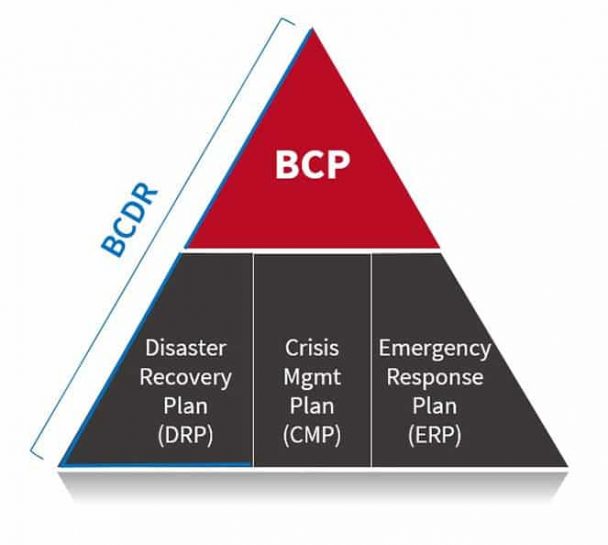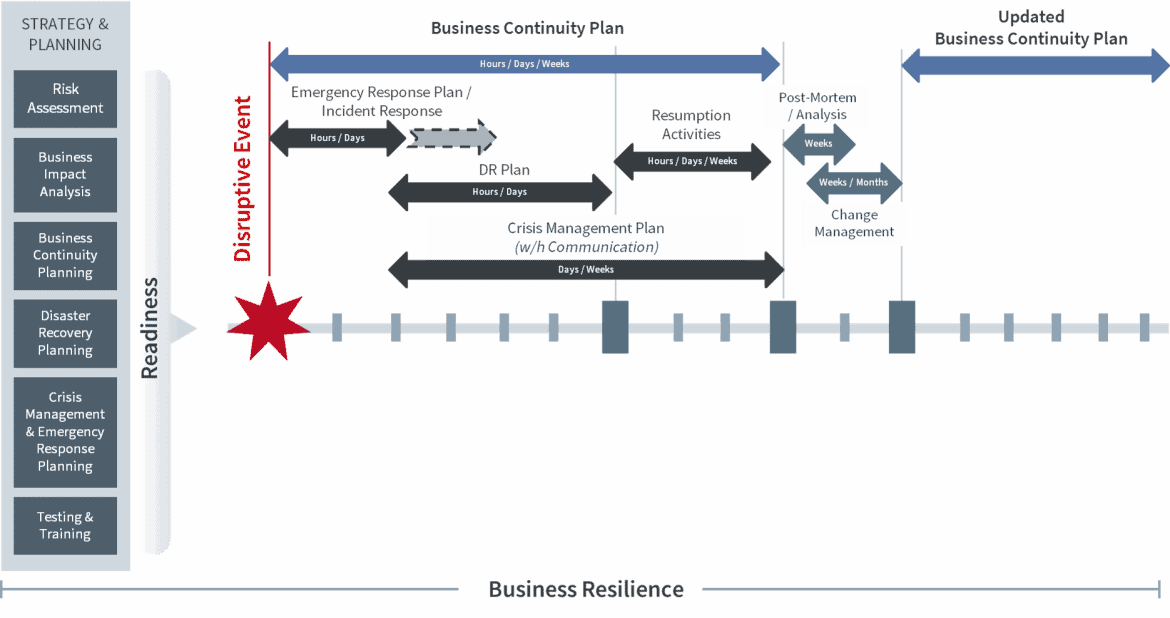What is Business Continuity
A-to-Zerto Glossary of Terms
Overview
Business continuity refers to an organization’s ability to operate uninterrupted. Generally, this means maintaining critical functions during an emergency, but it also encompasses planned downtime. Constant availability of employee- and customer-facing operations is both the goal of business continuity and a way to enable business resilience.
Related Topics
What Is Business Continuity ?
Business continuity means being connected and operational 24/7. This continuous availability and functionality of your organization is fundamental to maintaining brand trust and employee morale. Business continuity requires strategic planning, including a contingency plan for unplanned disruptions as well as investments that reduce planned downtime.
Business continuity encompasses the people, processes, technologies, and frameworks needed for an organization to ensure continuously deliver critical business functions when a disaster occurs.
Business Continuity (BC) Guide: Everything You Need to Know about BC
Why Is Business Continuity Important?
In today’s digital-first world, business continuity has become a commonplace expectation, even though it’s admittedly difficult to achieve. Regularly scheduled downtime will frustrate your employees and customers alike. Unplanned disruptions are also more common than ever, owing to a number of causes:
- Natural disasters
- Labor disagreements
- Digital heists and ransomware attacks
- System failures and outages
But failing to plan for unexpected disruptions could be disastrous for your organization. In a worst-case disruption scenario, a business may even close permanently. No matter the circumstance, any time offline can have potentially dire consequences. That's why business continuity is so important.
In an emergency, business continuity is going to:
- Ensure services or products are delivered to customers
- Support employees and their safety and security
- Map out the steps and actions to be taken
- Have the right technology and solutions in place for disaster recovery
What Does Business Continuity Means in a Business Emergency
Key Components of a Business Continuity Plan to Complete the 4 R's
According to ISO 22301¹, a business continuity plan is defined as “documented procedures that guide organizations to complete the four R’s—Respond, Recover, Resume, and Restore— to reach a pre-defined level of operations following disruption.” Therefore, at a minimum, the business continuity plan should contain some specific items.
- Contact information of the key individuals in charge of the business continuity plan
- Instructions about how to use the plan end-to-end
- Service level agreements over key business processes
- References to the DR, crisis management and emergency response plans
Key Elements of a Business Continuity Plan
The 3 Basic Elements of Business Continuity
Business continuity does not come up on its own, nor out of the blue. There are three foundational elements that make business continuity a reality.
This is the one team, or actually the many teams involved in the design, implementation, activation and maintenance of the business continuity plan(s). It is a cross-functional group that spans the entire organization from executives to front-line employees.
This is the set of activities required to establish a viable and effective business continuity plan. Business continuity planning is made of several parts such as business impact analysis (BIA) and risk assessment. Some key business continuity metrics —MDT and MTDL— also get established along the way. This planning process will only be as strong as the BCM team leading and running it, emphasizing the importance of the people involved and their expertise.
This is the result of the business continuity planning. The BCP is a document containing processes and procedures to be activated in the event of a disaster or major disruption. While aiming to ensure the business's continued operations, the business continuity plan also ensures the protection of an organization's employees, resources and assets. Very often, an organization has multiple BCPs, especially if it is large and with an international footprint.
Business Continuity vs Disaster Recovery?
Business continuity is interconnected with disaster recovery (DR), forming the common acronym of BCDR. Although the two terms tend to be used interchangeably, they aren’t identical. Business continuity means maintaining organizational operability, while disaster recovery denotes restoring IT systems after a disruption.

Business continuity planning establishes a business continuity plan, whereas disaster recovery planning produces a disaster recovery plan. The DR plan is a subset of the business continuity plan, along with the crisis management plan and the emergency response plan.
A DR plan may not always be triggered when the business continuity plan is invoked. There are situations that impact business continuity without affecting an organization’s IT infrastructure and systems. A staff strike at a hospital, for example, will likely activate business continuity and crisis management plans without needing to invoke any DR plan.
Business Continuity Plan (BCP) vs. Disaster Recovery Plan (DRP): What's the Difference?
The Plans in Business Continuity
Business Continuity vs Business Resilience?
Business continuity is critical to establishing an organization’s resilience against disruptive events in the immediate to short-term horizon.
Business continuity plans, which are the result of risk assessment, business impact analysis (BIA), and planning and testing activities, address several aspects of business resilience—including operational resilience, IT resilience, and cyber resilience—and set the readiness level of an organization.

When disruption strikes, various plans are invoked and executed as needed. After normal operations are restored, an organization usually conducts a post-mortem analysis to identify gaps and implement improvements that consequently update and enhance the business continuity plan. This builds and improves business resilience.
Comparing Resilience - Part One: Business Resilience
Comparing Resilience - Part 5: Resilience with Business Continuity and Business Strategy
Why Use Zerto for Business Continuity
An essential part of business continuity, disaster recovery focuses on IT and technology infrastructure. Zerto, a Hewlett Packard Enterprise company, is a DR solution that greatly reduces the downtime associated with unplanned disruptions and minimizes the impact of planned disruptions, enabling true business continuity. Zerto also enables an always-on experience, providing organizations with more time for innovation and business transformation.
The Zerto solution ensures that your IT systems are resilient through emergencies that threaten to disrupt your operations. Zerto enables IT transformation through a single, simple, and scalable solution that offers unparalleled protection. It includes features critical to business continuity:
- Instant file restore
- Automated VM protection
- Instant VM restore
- Real-time analytics and capacity planning
By taking away the risks and complexity of modernization and cloud adoption, the software-only Zerto solution supports true business continuity.
Zerto Solution Overview
Frequently Asked Questions
General Questions About Business Continuity
Q: Who is responsible for business continuity?
A: The business continuity management team is responsible for all the activities enabling business continuity. But that team is not a monolithic group: it is made of many people from different functions and spans across all layers of management (from executives to front line employees). In fact, it is often many teams instead of one. But at the end of the day, every employee carries the responsibility of ensuring business continuity in the face of a major disruption or disaster, by complying with steps and actions described in the activated BCP, either as a "commander" or "executioner".
Q: Is business continuity the same as business resilience?
A: Business continuity is a major element in enabling business resilience, especially in the face of operational risks, but it is only one facet of it. Business resilience is broader and considers other types of risks, usually more holistically managed under the risk management function in an organization.
Q: What is BCDR (Business continuity and disaster recovery)?
A: There can be two interpretations for this term. BCDR can refer to the part of business continuity that is covered by disaster recovery. Disaster recovery in itself is usually not enough to ensure business continuity —even if sometimes it does, when the disruption is self-contained in IT— because there are more than systems involved in business processes. However, in today's environment, most businesses rely on IT systems and applications, and therefore definitely need a solid disaster recovery strategy and plan.
BCDR can also mean the combination of an organization's business continuity plan with its disaster recovery plan. As mentioned above, the DRP would be part of the BCP, since the scope of the latter is broader than the former. A BCDR plan would therefore cover the recovery from an IT standpoint with all the steps and activities —beyond IT— to get the operations back to normal. This would apply to some types of disruptions, but not all.
Questions About the Business Continuity Plan - BCP
Q: How many business continuity plans, or BCPs, can a business have?
It all depends as no one business is similar to another. Based on the size and global footprint of an organization, there might be requirements to get specific BCPs by region, country or even site location. Also, some organizations may decide to have their BCP split into multiple ones to address specific types of risks, while others may decide to have everything under one master BCP. The BCM team will usually determine what is best for the business based on applicable compliance requirements and what the organization can manage from a complexity standpoint.
Q: How is a BCP activated or de-activated?
A business continuity plan can be activated at multiple levels of the business continuity chain-of-command. This is to ensure speed over the business reaction to a disruption. Then the situation may end up being managed at a level different from where it started. The de-activation of an active BCP is usually driven by the crisis management team, based on specific criteria spelled out in the BCP, and is a step-down process (it is not an On-Off transition).
Q: Who should have access to the BCP?
Anybody should be able to access the BCP. However, it is crucial that the individuals involved in executing the BCP —because of their role in its execution— could access it at any time, and especially during a crisis. Indeed, even if access to the BCP is not a substitute for training, during a crisis there might be a need to check some of its elements. Old-fashion printed versions of a BCP should not be discarded, as some type of disruptions may prevent access to a BCP in a digital format.
Q: What is the difference between a business continuity plan (BCP) and a disaster recovery plan (DRP)?
A DR plan helps to reduce the impact and duration of unexpected disruptions by minimizing the data loss and downtime of key IT infrastructure, systems, and applications. The BCP details your organization’s entire prevention, mitigation, response, and recovery protocols for all kinds of threats and disasters. The DRP is part of the BCP.
Other Resources
LATEST FROM ZERTO SEE ALL
Resource Center
Discover and access content from Zerto and 3rd parties (IDC, Gartner, ESG, etc.) related to Business Continuity.
The Key Components of a Business Continuity Plan (BCP)
Learn about the essential elements that should be part of any serious BCP.
Man-made Disruption: Ransomware
Ransomware attacks are capable of causing wide-spread disruption over supply-chains, services, institutions and more. Learn more about ransomware recovery.
What is Zerto?
Learn about Zerto and how it can help you solve your data protection and recovery challenges.